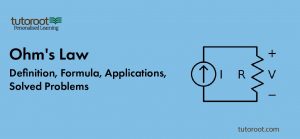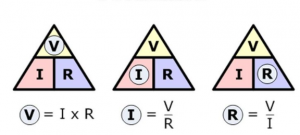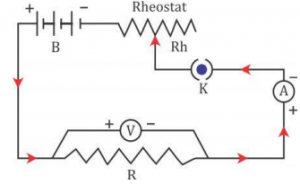Ohm’s Law – Definition, Formula, Applications
Ohm’s Law is a very important concept in the Physics subject, as many chapters and principles are derived from it. Most of the high-weightage questions and problems that students encounter in Physics examinations come directly from this topic. Moreover, to help these students out, we are going to give a comprehensive description of State Ohm’s law, its Applications, Ohm’s Law Formula and solving problems, and many more.
Ohm’s Law
As per Ohm’s Law, the voltage across a conductor is directly proportional to the current flowing through it, and this, provided all the physical conditions and temperatures stay constant and unchanged.
Thus, Ohm’s Law states that the current flowing through the conductor is directly proportional to the voltage across the circuit, i.e. V ∝ I. Ohm’s Law establishes the basic relation between the voltage applied and current through the conductor. Ohm’s Law is known to be the most important and primary basic law that helps us in dealing with electric circuits. Ohm’s Law also establishes that the current has a linear relationship with voltage.
Formula for Ohm’s Law

First of all, you must know that Ohm’s Law Definition is a principle that explains the relationship between three important quantities as Resistance, Current, and Voltage. Moreover, according to this law, the voltage across a conductor is directly proportional to the current flowing through it, while other physical conditions and temperatures are said to be constant.
Ohm’s Law Formula is as follows:
V = IR
| Quantity | Function | Unit of Measurement | Ohm’s Law Symbol |
| Voltage | Pressure causing flow of electrons | Volt(V) | E |
| Current | Rate of Flow of Electrons | Amp(A) | I |
| Resistance | Flow Inhibitor | Ohm(Ω) | R |
Units of Measurement: Volt(V), Amp(A), Ohm(Ω)
Similar to all other physical quantities involved in the subject, Ohm’s law has its own units of measurement. More importantly, Ohm’s law has a dedicated symbol to signify each quantity involved such as,
- Current = I
- Voltage = V or E
- Resistance = R
Besides, each quantity also has a specified unit measurement, to calculate the experimental values, and is generally named after the scientists who invented them. For instance, the Volt is named after its founder, Alessandro Volta, while Ohm is after German George Simon Ohm, and lastly, Amp is after Andre M. Ampere.
Ohm’s Law is established more effectively in situations when physical conditions such as temperature and others are constant. This is because the current flowing through the circuit varies according to the changes in the temperature. Hence, in circumstances where physical factors like temperature turn influential, Ohm’s law is seen as violating.
Ohm’s Law Unit
Besides Ohm’s Law Formula, the law that has three physical quantities associated with it needs to be understood. These three factors of Ohm Law are:
- Current
- Voltage
- Resistance
Relationship Between Voltage, Current, and Resistance

From the above sections, as you can guess, the voltage, current, and resistance quantities have a relationship with each other which is explained by Ohm’s Law.
E = I × R
For Calculating Current, I = E/R or V/R
Resistance, = E/I or V/I
Ohm’s Law Experimental Verification

Apparatus
- Voltmeter
- Ammeter
- Battery
- Plug Key
- Rheostat
- Resistor
To verify Ohm’s Law Derivation, the candidates must follow the steps given below.
Procedure
- Firstly, adjust the rheostat in a way that the K component is closed, and get a minimum reading on Ammeter (A) and Voltmeter(V).
- Now, the current is slowly increased by gradually moving the rheostat. Now the current flow in the circuit and the potential difference in value across the resistance wire are noted.
- After this, different sets of values of current and voltage are obtained, and at the same time, the ratio of V/I is calculated for each one of these sets.
- Moreover, you should know that the calculated V/I value is equal to Resistance, R which is constant.
- And lastly, draw a graph between the potential difference against the current, which will explain, why the current is proportional to a potential difference.
Ohm’s Law Magic Triangle
Ohm’s Law Magic Triangle is an illustrative representation that helps us get oriented about the Ohm’s Law relation between voltage, current, and resistance. This triangle helps remember the order of the relationship between the three main aspects: current (I), voltage (V), and resistance (R).
If the value of voltage is what we need to get and the current and resistance values are present, then to calculate voltage simply cover V at the top. So, now we have the I and R or I × R. Thus, the Voltage equation is Current multiplied by Resistance.
Vector Form of Ohm’s Law
The Ohm’s law vector form is,
vec = σvec{E}
where
vec is Current Density vector,
vec{E} is Electric Field vector,
σ is conductivity of material.
Calculating Electrical Power Using Ohm’s Law
What is electric power?
Electric power is the rate at which energy is converted from the electrical energy of the moving charges to another form of energy such as heat, mechanical energy, or energy stored in magnetic fields or electric fields. We all know that the unit of electric power is watt. This electrical power is calculated by applying Ohm’s law and by substituting the values of voltage, current, and resistance.
Formula to find power
When the values for voltage and current are given,
P = VI
When the values for voltage and resistance are given,
P =V2/R
When the values for current and resistance are given,
P = I2R
Applications of Ohm’s Law
In the circumstances where the other two numbers are known, Ohm’s law is applied to arrive at the voltage, current, impedance, or resistance of a linear electric circuit.
Major applications of Ohm’s Law:
- Ohm’s Law makes power calculations easier
- Ohm’s Law is applied to maintain the desired voltage drop between the electrical components
- To determine the electric circuit’s voltage, resistance, or current
- Ohm’s law is also used to redirect current in DC ammeters and other DC shunts
Conclusion
In the above article, we have helped you understand Ohm’s Law, its various formulas, applications, and many more. And if you are having problems understanding other formulas and principles, in Physics. Then the online interactive classes with expert staff guidance from the Tutoroot might be very beneficial for you. Additionally, the tutoring programs have many other unique features and benefits such as Doubt Clarification Sessions, Best Study Materials, Mock Tests, and many more.
FAQs
What is the law or Ohm Law definition?
As per Ohm’s Law, the voltage across a conductor is directly proportional to the current flowing through it, and this, provided all the physical conditions and temperatures stay constant and unchanged.
Thus, Ohm’s Law states that the current flowing through the conductor is directly proportional to the voltage across the circuit, i.e. V ∝ I. Ohm’s Law establishes the basic relation between the voltage applied and current through the conductor. Ohm’s Law is known to be the most important and primary basic law that helps us in dealing electric circuits. Ohm’s Law also establishes that the current has a linear relationship with voltage.
What are the 3 formulas in Ohm’s Law?
V = R x I
R = V/I
I = V/R
What is the SI unit of Ohm’s law?
The SI unit is Ohm (Ω)
Who discovered Ohm’s Law?
German physicist Georg Simon Ohm
